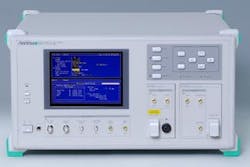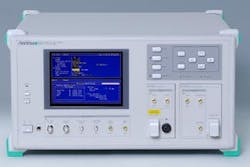40G jitter analyzer targets ITU-T O.172 systems, devices
May 11, 2005 Richardson, TX -- Anritsu has launched its MP1797A jitter analyzer for conducting measurements on 40G transmission devices and systems in accordance to ITU-T Standard O.172. The company says the analyzer performs the five most common jitter measurements (generation, tolerance, sweep, transfer, and frequency sweep) with a high degree of accuracy, owing to its customized software, a built-in jitter generator and receiver, and its high-performance O/E and E/O modules.
The company says the analyzer's high performance measurement capability makes it an essential tool for measuring intrinsic jitter while evaluating the performance of OC-768 and STM-256 devices during development and manufacturing. The device can also be used during the evaluation and installation of OC-768 and STM-256 transmission systems.
The device's internal jitter generator outputs a 39.81312-GHz jittered clock with jitter modulation frequencies up to 320 MHz, and modulation amplitudes up to 16,000 UIp-p. The jitter generator also has a frequency offset function that varies from -100 ppm to +100 ppm. According to the company, utilizing both low- and high-pass filters that are defined by ITU-T O.172, the jitter receiver accurately detects and analyzes the clock. In addition to a 1/1 clock, the company says the device's 1/16 and 1/64 clock outputs allow it to perform highly accurate transponder tests.
The company notes that measurement accuracy is ensured, in part, by the device's MU179701A E/O unit and MU179702A 39.8-Gbit/sec O/E module. Used with the jitter generator and a BERT transmitter, the MU179701A converts 25-43-Gbit/sec NRZ electrical data to optical NRZ data for transmission. It features a high output power of 0 dBm +/-3 dBm and has a clock delay function of 0/-20 ps in 1 ps steps. The MU179702A receives the optical data, recovers the jitter clock, and transmits the signal to the jitter receiver. It has a 320-MHz wideband clock/data recovery, as well as a narrowband CDR of <16 MHz to ensure jitter measurement accuracy. The MU179702A also has wide sensitivity of 0 to -10 dBm, and is available with an internal optical power meter.
The MX179701A jitter measurement application software allows all measurements to be performed automatically. In addition, the software can convert jitter transfer and jitter tolerance test results and display them in chart form for reporting purposes.
The analyzer's pricing is available upon request.
